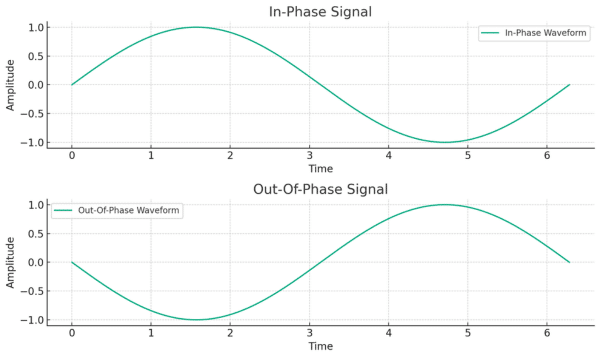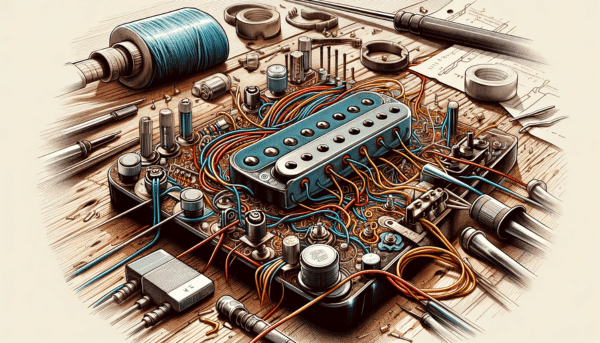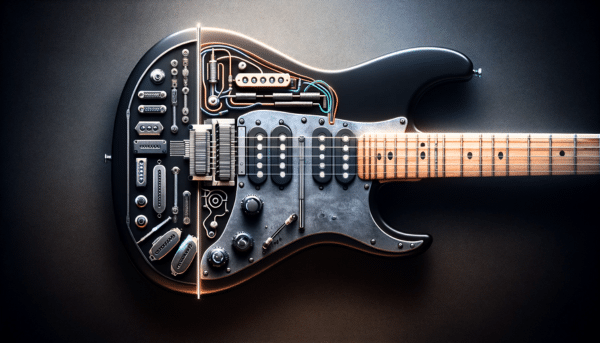Hey there, guitar aficionados! Ever pondered the question, “Can You Mix And Match Guitar Pickups?” Well, you’re in for a sonic adventure! This article is your gateway into the thrilling realm of guitar customization. Whether you’re a strumming veteran or a budding rocker, mastering the art of mixing pickups can dramatically transform your guitar’s voice.
Dive into the secrets of blending different pickup types, from the mellow humbucker’s warmth to the sharp clarity of single-coils. This guide is more than just technical talk; it’s a roadmap to elevating your guitar tone. With practical tips and insightful techniques, you’re about to embark on a journey that will take your sound to exciting new places. So, plug in and let’s explore the vast world of guitar pickup combinations together!
The Short Answer
Mixing different types of pickups, like humbuckers and single-coils, allows you to customize your guitar’s sound uniquely. While it offers creative tonal possibilities, it’s important to consider compatibility, phase issues, and volume balance. With some experimentation and technical adjustments, you can create a guitar setup that perfectly aligns with your desired sound and playing style.
Key Takeaways

Here are the essential points to remember about mixing guitar pickups.
- Compatibility Matters: When mixing and matching guitar pickups, ensure the pickups are compatible in terms of output and tonal characteristics to avoid unwanted sound discrepancies.
- Understand Pickup Types: Gain a clear understanding of the different types of pickups (humbucker, single-coil, active, passive) and how each affects your guitar’s sound, as this knowledge is crucial for effective mixing.
- Phase Awareness: Be aware of phase issues that can occur when mixing pickups from different brands or types, which can lead to sound cancellation or thinning.
- Volume Balancing: Pay close attention to the volume output of each pickup. Adjustments may be required to achieve a balanced sound between the mixed pickups.
- Technical Tweaking: Be prepared to make technical adjustments like flipping wires or changing potentiometer values to resolve phase or volume issues.
- Importance of Trial and Error: Embrace a trial and error approach. Testing different combinations in various settings is key to finding the perfect mix.
- Professional Assistance: Don’t hesitate to seek professional help for installation and adjustments, especially if you’re not comfortable with the technical aspects.
- Custom Wiring Solutions: Consider custom wiring solutions, such as blending circuits for active and passive pickups, to achieve the desired outcome.
- Contextual Use: Test your mixed pickups in different contexts (live performance, recording) to ensure they perform well in all environments.
- Personalization Is Key: Remember, mixing pickups is about personalizing your guitar to suit your unique style and sound preferences. Trust your ears and play with different combinations to find what works best for you.
Keep On Reading (Below) To Learn More
Why Mix Guitar Pickups?
There are many ways to create a sound that’s uniquely yours. One way to achieve this on your guitar might be through mixing and matching pickups. Yes, the idea is not only possible but also a practice that can lead to an extraordinary palette of tones.
However, different pickup brands can have varied magnet orientations, which can lead to potential issues when combining them. Taking Seymour Duncan and Fender pickups as examples, it’s not uncommon for them to be out of phase with each other.
While phase problems could sound intimidating, the rewards can easily be worth the trouble! A careful mix can result in a sound that is rich, unique, and resonant with the complexity we often strive for as musicians. Imagine the warm depths of humbuckers interwoven with the bright snap of single-coils. The result? A range of tonal options at your fingertips, from whisper-soft melodies to the raw punch of rock.
Experimentation is Key!
The tones and gain levels may vary and might require some trial and error to achieve the balance you’re after, so it’s essential to approach this with an open mind, ready for a bit of experimentation.
The endeavor becomes even more complex when considering mixing active with passive pickups. It’s a path tread by few, and it requires a deeper understanding of how these pickups differ in terms of power requirements and output levels.
So, bear in mind that embarking on this quest for the perfect blend of pickups is likely to be a journey filled with adjustments and learning. But don’t worry; I’ll guide you through the technical maze in the sections to come, starting with diving into the mysteries of phase, next.
This table provides a quick overview of the different types of pickups, their sound characteristics, and the typical musical genres they are used in.
| Pickup Type | Sound Characteristics | Typical Usage |
|---|---|---|
| Single-Coil | Bright, crisp, and articulate; prone to hum | Favored in blues, country, and classic rock |
| Humbucker | Warm, full, and rich; less noise | Popular in rock, metal, and jazz genres |
| Active | Higher output, clear, consistent tone; requires battery | Used in hard rock and metal for high gain |
| Passive | Classic, natural sound; varied output levels | Versatile, used across various music genres |
Understanding Pickup “Phase”
When you’re gearing up to mix guitar pickups, phase is your navigator—the compass to your tonal map. Phase determines how pickups interact with each other, and understanding it is crucial. Simply put, phase refers to the timing of the electrical signals that pickups send to your amp.
If two pickups are out of phase, one might be sending a peak signal when the other sends a trough, effectively thinning the sound or causing signal cancellation. This might happen when mixing brands like Seymour Duncan and Fender, as stated above. The result is a weak or hollow tone, which may be an unintended, undesirable effect.
Correcting phase issues isn’t rocket science but does require some technical savvy. You’d typically flip the hot and ground wires of one pickup, or sometimes, a manufacturer will provide a phase reversal switch. It’s a tweak that brings the signals of both pickups into a coherent waveform, thickening the sound and ensuring neither pickup’s nuances go unnoticed.
The diagram below visually compares the difference between in-phase and out-of-phase signals. The in-phase waveform results in a strong, coherent sound. In contrast, an out-of-phase waveform is inverted relative to the other, leading to potential sound cancellation or a thin, hollow tone.

Keep in mind, phase is just one piece of the puzzle when you’re blending the sonic characters of different pickups. How they are wired together is equally important for balancing the tonal outcome of your guitar. Going forward, I’ll unpack the intricacies of wiring and setup adjustments that will help your mixed pickups play nice together.
Sculpting Sound: The Tech Behind Wiring and Setup Adjustments

When I consider mixing guitar pickups, I always look at the technical side of things. Wiring and setup adjustments can make or break the sound you’re envisioning. It’s not just about slotting in a new pickup; the entire electrical ecosystem of your guitar might need a tweak.
Pickup wiring is crucial because it can affect volume balance, tone, and interaction between pickups. For instance, you might find that after installing a hot bridge humbucker alongside a milder neck single-coil, your volume levels are mismatched. Or blending them might not yield the harmonious tone you expected. Getting into the nitty-gritty, things like potentiometer values, capacitor choices, and even the wiring’s physical layout come into play.
For example, here is a diagram that shows how a single-coil neck pickup can be added to a guitar that is wired to work with a humbucking bridge pickup. Both pickups are being wired through the same volume pot.

However, the single-coil pickup is not designed to be used with this size (resistance) potentiometer, which may cause a problem with how the single-coil and the combination of the two pickups sound.
On the overall, single-coil pickups like 250K potentiometers, while humbucking pickups sound and play better with 500K pots. Mixing these two pickups together with a single 250K or 500K volume control might require the installation of additional fixed-value resistors to compensate for the difference between the two.
This table highlights popular combinations of pickups and the unique sounds they produce, along with famous guitarists known for using these combinations.
| Combination | Resulting Sound | Notable Users |
|---|---|---|
| Humbucker/Single-Coil | Versatile; warm from humbucker, bright from single-coil | Keith Richards, Steve Vai |
| Single-Coil/Single-Coil | Bright and crisp, classic single-coil tone | David Gilmour, John Mayer |
| Humbucker/Humbucker | Full and rich, powerful output | Jimmy Page, Slash |
| Active/Passive | Dynamic range; clarity from active, warmth from passive | Kirk Hammett, Synyster Gates |
Typically, guitar setup adjustments following a pickup change involve action and intonation tweaks. This ensures the strings respond well to the new dynamics and maintains the overall playability of the instrument. For example, a bridge pickup with a higher output might lead to a more pronounced downward string pull, necessitating a slight action adjustment to prevent buzzing.
Get the Help You Need
A note of caution, though: not every guitar player is a tech whiz, and that’s perfectly fine. If terms like ‘soldering’ or ‘pot values’ make you uneasy, seeking professional help is a wise move. It saves you from the frustration of a trial-and-error approach, and a seasoned tech can provide valuable insight. They’ll likely have dealt with a similar situation before and can steer your guitar pickup installation toward the sound deep in your mind.
So before we delve into the next section, remember that the key is BALANCE. Whether you’re striking a balance between volume, tone, or the technical interplay of components, a carefully thought-out approach to wiring and setup is essential for harmony within your guitar’s new configuration.
Matching Tones and Gain Levels
When blending different pickups in a guitar, one aspect I pay close attention to is ensuring the harmony between tones and gain levels. Mismatched pickups can produce sounds that clash harshly or simply fail to complement each other. This dissonance is precisely what I aim to avoid.
The trick lies in achieving a balance where each pickup contributes to an overall sound that’s both unified and unique. It’s almost akin to mixing colors on a painter’s palette: the final hue can be dulled or vibrant, depending on your choices. Similarly, the tone from your mix of pickups can either dazzle with complexity or muddle into obscurity.
To refine this process, I often turn to the controls on the guitar itself and the amplifier. Adjusting volume pots, tone knobs, and the amp’s equalization settings can make a substantial difference. It’s a practice of trial and error, requiring a mix of technical knowledge and an intuitive feel for the sound.
Beyond the instrumentation, the playing context matters, too. For instance, one pickup might overpower the other in a live band setting. That’s where fine-tuning the gain comes in, to ensure neither pickup drowns out its counterpart and each has its moment to shine.
Embrace the Possibilities
But this process isn’t just about avoiding pitfalls; it’s about embracing possibilities. Having diverse pickups means having access to a rich palette of tonal colors. If a guitarist knows how to leverage this, they can tailor their sound to genres ranging from jazz’s smoothness to metal’s roar without skipping a beat.
Seamlessly integrating this palette leads us to the next consideration—the division between active and passive pickups. As we transition into discussing this blend, it’s worth highlighting that while the tonal balance remains crucial, it’s the technical specifics that could steer the entire endeavor.
Combining Active and Passive Pickups

I understand the allure of a guitar that can do it all, shifting from a throaty growl to a crisp twang with a flick of the switch. Many guitarists dream of such versatility, which often leads to exploring the option of mixing active and passive pickups in a single instrument.
At the core, active and passive pickups are two distinct beasts. Passive pickups, which have been around since the early days of electric guitars, rely solely on the string’s vibration over the magnets to generate a signal. Active pickups, in contrast, require a battery-powered preamp to boost the signal and control tone.
Marrying these two technologies can be tricky. Active systems can sometimes overpower passive ones, leading to an imbalance in output. Moreover, integrating a battery compartment and additional circuitry can be a complex task, particularly if you’re endeavoring to do this without altering the guitar’s original design.
This table provides a clear overview of the key aspects to consider when combining active and passive pickups in a guitar, along with practical tips to address each aspect.
| Aspect | Considerations | Tips |
|---|---|---|
| Wiring Complexity | More complex due to different power requirements and signal levels | Consider using a pre-made kit or consult a professional for wiring |
| Volume Balancing | May need special circuits or controls to balance the different output levels | Use a balance potentiometer or active/passive switch for volume control |
| Tone Control | Tone controls might need to be adjusted separately for each type | Customize tone circuits or use separate tone controls for each pickup type |
| Battery Requirements | Active pickups require a battery, which needs to be accommodated in the guitar body | Ensure easy access to the battery compartment for replacements |
Looking Before You Leap
Still, I’m not here to discourage you. On the contrary, the combination can yield a remarkable range of tones if done correctly. The trick lies in understanding the electronic requirements and, most importantly, ensuring the signal from the passive pickup is adequate to match the output of the active system.
Depending on your technical skill, you might consider doing the modifications yourself or seeking a professional’s help. There are pre-made kits that facilitate the blending of active and passive circuits, but don’t underestimate the work involved in terms of wiring and space allocation within your guitar’s cavity.
With the technical groundwork laid out, your creativity gets to take center stage. How will you use this newfound tonal palette? That’s what we’ll explore in the next section, where I guide you from concept to concert.
Practical Steps for Mixing Pickups
So, you’ve embarked on the adventure of creating your own unique guitar sound by mixing pickups, and you now understand the various considerations, from phase issues to the technicalities of wiring. But how do you bring all this information from concept to actual play? Here’s a simple guide to help you turn your vision into reality:
Start by researching. Look into the specific qualities of different pickups and how they’re commonly used. Find your sound by listening to guitars that use the kinds of pickups you’re interested in.
Next, focus on compatibility. Consider how the pickups you’ve chosen will work together. Will they complement or clash?
Once you’ve made your choices, it’s time for a little trial and error. Install the pickups and test them out with your amp and effects.
Pay attention to how they interact. While some pickups might create beautiful harmonies together, others might compete or even cancel each other out.
If you run into issues, remember you can alter the phase and balance the gain between pickups to achieve the harmony you’re aiming for.
Keep close communication with an experienced technician who can make the necessary modifications while ensuring the health of your guitar.
After some tweaking, you’ll likely find a setup that resonates with your style. Remember, this process is as much about personal expression as it is about technical precision.
Finally, when you’ve got that perfect mix, practice until the new sound feels like second nature. Then, take it to the stage with confidence, knowing you’ve crafted a sound that’s distinctly yours.
Troubleshooting Pickup Problems
This table provides practical solutions to common problems that might arise when mixing different types of guitar pickups, helping you to troubleshoot and optimize your custom setups.
| Common Issue | Possible Cause | Solution |
|---|---|---|
| Phase Cancellation | Incorrect wiring or polarity mismatch | Reverse the wires of one pickup or use a phase switch |
| Volume Imbalance | Differing output levels of pickups | Adjust pickup heights or use a balance potentiometer |
| Tonal Mismatch | Mismatched characteristics of pickups | Experiment with different pickup combinations |
| Excessive Hum or Noise | Grounding issues or interference | Check wiring and shielding, consider noise-canceling options |
| Physical Fit Problems | Different sizes or formats of pickups | Modify the pickguard or guitar body, if necessary |
My Personal Experience With Mixing Pickups

Many years ago, during a recording session, I had an unforgettable experience with my mixed-pickup guitar. I was super excited to lay down a track with my new setup – a humbucker at the bridge and a single-coil at the neck. It was supposed to be a smooth session, but boy, was I in for a surprise!
As I started playing, something sounded off. The beautiful, rich tone I expected was nowhere to be heard. Instead, it was thin and kind of weak. I was puzzled. I had mixed a powerful humbucker known for its deep, warm sound with a bright, clear single-coil. Why wasn’t it working?
I remembered something about “phase issues.” So, I stopped and checked my guitar. Sure enough, the pickups were out of phase. This means that the electrical signals from each pickup were clashing with each other. Imagine two friends trying to talk at the same time; it’s hard to understand either of them, right? That’s what was happening with my guitar’s sound.
Taking Action
But I wasn’t going to let this stop me. I grabbed my tools and flipped the wires on one of the pickups. This might sound scary, but it’s like switching two puzzle pieces so they fit better. After doing this, I played again. This time, the sound was much fuller and richer – just what I wanted!
Another problem was the volume balance. The humbucker was much louder than the single-coil. It’s like having one person shout while the other whispers. Not great for a balanced sound. So, I adjusted the height of the pickups. Bringing the single-coil closer to the strings made it louder, and moving the humbucker a bit away made it quieter. This way, they both had a similar volume.
Then came the real test – recording with my band. The mixed pickups sounded amazing in the studio! The humbucker gave the power for rock parts, and the single-coil added a sweet tone for softer sections. It felt like having two guitars in one!
This experience taught me a lot. Mixing pickups is not just about putting them together; it’s about making them work in harmony. It takes patience and a bit of tweaking, but the unique sound you get is totally worth it. So, if you’re thinking of mixing pickups, go for it! Just be ready to experiment and adjust until you find your perfect sound.
Frequently Asked Questions
Here are some of the questions I get asked about mixing guitar pickups.
If your question does not appear here, please put it in the comments, and I will get right back to you with an answer.
Is It Necessary To Modify The Guitar Body When Mixing Pickups?
It’s not always necessary to modify the guitar body when mixing pickups. Most standard pickups are designed to fit common guitar configurations. However, some custom or unconventional pickups might require slight modifications to the body or pickguard.
However, if you’re planning on adding a standard humbucking pickup to a guitar that’s routed for a single-coil cavity, prepare to widen it.
How Does Mixing Pickups Affect The Resale Value Of My Guitar?
Mixing pickups can either increase or decrease the resale value of your guitar, depending on the buyer’s preferences. Custom modifications might appeal to players looking for a unique sound, but others may prefer a guitar in its original configuration.
Are There Any Pickups That Should Not Be Mixed?
Generally, most pickups can be mixed, but certain combinations might not yield the desired sound. For example, mixing a high-output active pickup with a low-output passive one without proper adjustments could lead to imbalances in tone and volume.
What Tools Do I Need For Mixing And Installing Pickups?
The basic tools for mixing and installing pickups include a soldering iron, solder, screwdrivers, wire cutters, and possibly a multimeter. It’s also good to have some electrical tape or heat shrink tubing for insulation purposes.
How Long Does It Typically Take To Install And Adjust Mixed Pickups?
The installation and adjustment time can vary, but typically it might take a few hours. This time can increase if you’re new to the process or if extensive modifications are needed.
Can Mixing Pickups Change The Guitar’s Overall Weight?
Mixing pickups can slightly change the guitar’s overall weight, especially if you’re replacing lighter pickups with heavier ones or vice versa. However, this change is usually minimal and not significant enough to affect the guitar’s balance or playability.
Do I Need To Change The Strings When Mixing Pickups?
You don’t necessarily need to change the strings when mixing pickups unless they are old or damaged. However, fresh strings can help you better assess the new pickups’ impact on your guitar’s sound.
I like to put on a new strings whenever I take off an old set.
How Does The Position Of The Pickup (Neck, Middle, Bridge) Affect The Sound?
The position of the pickup significantly affects the sound. Neck pickups generally offer a warmer, fuller tone, while bridge pickups tend to be brighter and more aggressive. The middle position often provides a balanced tone.
Can I Mix Single-Coil And Humbucker Pickups In One Guitar?
Yes, mixing single-coil and humbucker pickups is a popular choice among guitarists. This combination offers a wide range of tonal possibilities, from bright and clear single-coil sounds to the rich, warm tones of humbuckers.
Will Mixing Pickups Require A New Wiring Harness?
Mixing pickups might require a new wiring harness if the new pickups have different wiring requirements or if you want to add features like coil-splitting. However, in many cases, the existing wiring can be adapted.
Do Mixed Pickups Require Special Amplifiers Or Effects?
Mixed pickups don’t require special amplifiers or effects. However, the unique combination of pickups might inspire you to experiment with different amp settings or effects to fully explore the new range of tones.
Active and passive pickups can share the same controls, but it may require a special wiring setup. This is because active pickups usually have a higher output and might need different potentiometer values.
How Do I Know If My Mixed Pickups Are Out Of Phase?
If your mixed pickups are out of phase, you’ll typically hear a thin, hollow sound when both pickups are active. This is due to the pickups canceling out certain frequencies when they’re working together.
Is It Possible To Mix Pickups With Different Magnet Types?
Yes, you can mix pickups with different magnet types (like Alnico and Ceramic). Each magnet type has its own tonal characteristics, and mixing them can create unique sounds.
Does The Cable Length Affect The Sound When Mixing Pickups?
Cable length can affect the sound of any guitar and pickup combination, especially with passive pickups. Longer cables can cause some signal loss, potentially leading to a slight reduction in high frequencies.
Can I Use Different Brands Of Pickups In The Same Guitar?
Yes, you can use different brands of pickups in the same guitar. Just make sure that their specifications are compatible, and be prepared to make necessary adjustments for optimal performance.
How Does Pickup Mixing Impact The Use Of Tone And Volume Controls?
Mixing pickups can impact how you use tone and volume controls, as each pickup might respond differently to these adjustments. You may find yourself tweaking these controls more often to achieve the desired balance.
What Is The Best Way To Test The Sound Of Mixed Pickups?
The best way to test the sound of mixed pickups is to play through a familiar amplifier and settings, in an environment where you can clearly hear the nuances, like a quiet room or a studio. Recording your playing can also help you analyze the sound more critically.
Should I Consult A Professional Before Mixing Pickups?
If you’re unsure about the technical aspects of mixing pickups or if the process involves complex modifications, consulting a professional is advisable. They can provide valuable advice and ensure the modifications are done correctly.
Can You Mix Pickups From Different Guitar Brands?
Yes, you can mix pickups from different guitar brands. However, it’s important to check for compatibility in terms of output levels and tonal qualities. Some brands might have different wiring or magnetic polarity, which could affect the phase and overall sound.
Putting It All Together
Wrapping up our journey through “Can You Mix And Match Guitar Pickups,” we’ve uncovered some truly eye-opening insights. This technique isn’t just about slapping different pickups together; it’s a thoughtful process of matching and balancing to create a sound that’s uniquely yours. Whether you’re new to guitar playing or have been strumming for years, the way you mix pickups can bring a whole new dimension to your music.
Key takeaways include the importance of compatibility between pickups and being mindful of issues like phase and volume balance. Adjustments might be necessary, and sometimes you might need a bit of professional help, especially with the wiring. Don’t forget, experimenting in different settings like live performances or recording sessions can help you find the perfect combination.
Lastly, remember that customizing your guitar with mixed pickups can change its feel and response a little. But what’s most exciting is the unique sound you can achieve. It’s about personal expression and finding the tones that resonate with you. So go ahead, explore the world of guitar pickups, and have fun creating a sound that’s as unique as your musical journey!

Here’s a video from Thomann’s Guitars & Basses that shows you one way to use a resistor to mix different types of pickups on the same guitar. Check it out!
What To Read Next ➡ Humbucker Pickups VS Single Coil – Improve Your Guitar Tone!
What’s On Your Mind?
Here’s where you get to give me your take on mixing guitar pickups! Don’t hold back if you have something to say or there’s a question you need answered. Jump right into the comments section below, and let it rip!
- Have you ever tried mixing and matching guitar pickups on your guitar? Tell us about your experience and the unique sounds you created!
- If you’ve experimented with mixing pickups, what challenges did you face and how did you overcome them? Your tips could help fellow guitar enthusiasts!
- If you could design your dream guitar, what pickups would you mix and match? Describe your ideal setup and why you think it would sound amazing.
- What else is on your mind?
I’m here to help!


